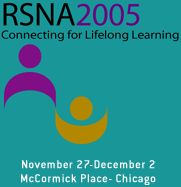
Abstract Archives of the RSNA, 2005
John Perry BS, Presenter: Nothing to Disclose
Victor Mellet Haughton MD, Abstract Co-Author: Nothing to Disclose
Yijing Wu, Abstract Co-Author: Nothing to Disclose
Paul Anderson MD, Abstract Co-Author: Nothing to Disclose
Chuck Mistretta PHD, Abstract Co-Author: Nothing to Disclose
Eric Krueger BA, Abstract Co-Author: Nothing to Disclose
Jason P Fine, Abstract Co-Author: Nothing to Disclose
et al, Abstract Co-Author: Nothing to Disclose
To study the effect of degeneration and aging on intervertebral disks, grading systems were developed based on the morphological changes evident in anatomic sections or MR images. Greater accuracy and sensitivity would be possible with a continuous grading system. T2 measurements have been proposed for this purpose, since average T2 of the disk correlates with water content, changes with age and with the presence of degenerative changes. In a pilot study we measured the T2 in subjects with and without symptoms of back pain.
An FSE acquisition was modified to display signal intensity for each voxel for each image in the echo train. T2 maps were calculated automatically by a least squares fitting routine from the signal intensity. A 7 mm thick slice was acquired with the FSE sequence in asymptomatic volunteers in their second or fourth decades of life and volunteers with back pain consistent with disk degeneration. T2 values were compared with ANOVA and t-tests between normal and abnormal disks and between the younger and the older subjects. The effect of spinal level on the intervertebral disk, the spatial distribution of T2 values and the number of T2 values in each range of values were also studied. Enrollment of subjects in the first decade of life has begun.
Average T2 for lumbar intervertebral disks was 108 ms in the second decade of life and 85 ms in the fourth decade of life. In disks with evidence of degeneration in the fourth decade of life, the average T2 was 53 ms. There is a significant difference (p = .004) between the average T2 in normal disks of subjects in the second decade and fourth decade of life. Furthermore, there were significant differences between degenerate disks from the fourth decade and normal disks from fourth decade and second decade of life. The distribution of T2 values in normal and degenerating disks was different.
With aging, the T2 values of the intervertebral disk decrease and with degeneration they decrease more rapidly. Measurement of T2 may provide a means to study aging and to detect early degeneration and to monitor the effect of experimental therapies on the intervertebral disk.
Perry, J,
Haughton, V,
Wu, Y,
Anderson, P,
Mistretta, C,
Krueger, E,
Fine, J,
et al, ,
Quantitative Assessment of Intervertebral Disk Aging and Degeneration with the Measurement of T2 Relaxation. Radiological Society of North America 2005 Scientific Assembly and Annual Meeting, November 27 - December 2, 2005 ,Chicago IL.
http://archive.rsna.org/2005/4406248.html

